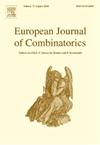Boundary rigidity of 3D CAT(0) cube complexes
IF 1
3区 数学
Q1 MATHEMATICS
引用次数: 0
Abstract
The boundary rigidity problem is a classical question from Riemannian geometry: if is a Riemannian manifold with smooth boundary, is the geometry of determined up to isometry by the metric induced on the boundary ? In this paper, we consider a discrete version of this problem: can we determine the combinatorial type of a finite cube complex from its boundary distances? As in the continuous case, reconstruction is not possible in general, but one expects a positive answer under suitable contractibility and non-positive curvature conditions. Indeed, in two dimensions Haslegrave gave a positive answer to this question when the complex is a finite quadrangulation of the disc with no internal vertices of degree less than 4. We prove a 3-dimensional generalisation of this result: the combinatorial type of a finite CAT(0) cube complex with an embedding in can be reconstructed from its boundary distances. Additionally, we prove a direct strengthening of Haslegrave’s result: the combinatorial type of any finite 2-dimensional CAT(0) cube complex can be reconstructed from its boundary distances.
三维 CAT(0) 立方体复合物的边界刚度
边界刚度问题是黎曼几何中的一个经典问题:如果 (M,g) 是一个具有光滑边界的黎曼流形,那么 M 的几何形状是否由边界 ∂M 上的度量 dg 决定?在本文中,我们将考虑这一问题的离散版本:我们能否根据有限立方体复数的边界距离确定其组合类型?与连续的情况一样,重构在一般情况下是不可能的,但我们期望在适当的收缩性和非正曲率条件下得到肯定的答案。事实上,在二维中,当复数是一个内部顶点度数不小于 4 的有限圆盘四曲面时,哈斯勒格拉夫给出了肯定答案。我们证明了这一结果的三维概括:一个嵌入 R3 的有限 CAT(0) 立方复数的组合类型可以从其边界距离中重建。此外,我们还证明了哈斯勒格拉夫结果的直接强化:任何有限二维 CAT(0) 立方复数的组合类型都可以从其边界距离中重建。
本文章由计算机程序翻译,如有差异,请以英文原文为准。
求助全文
约1分钟内获得全文
求助全文
来源期刊
CiteScore
2.10
自引率
10.00%
发文量
124
审稿时长
4-8 weeks
期刊介绍:
The European Journal of Combinatorics is a high standard, international, bimonthly journal of pure mathematics, specializing in theories arising from combinatorial problems. The journal is primarily open to papers dealing with mathematical structures within combinatorics and/or establishing direct links between combinatorics and other branches of mathematics and the theories of computing. The journal includes full-length research papers on important topics.

 求助内容:
求助内容: 应助结果提醒方式:
应助结果提醒方式:


